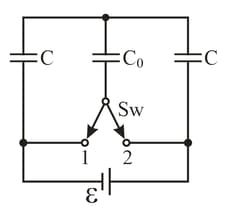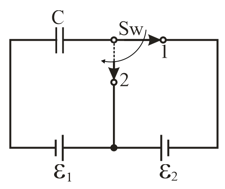Determine the interaction energy of the point charges located at the corners of a square with the side , in the circuits shown in the figures.



Important Questions on ELECTRODYNAMICS
There is an infinite straight chain of alternating charges and . The distance between the neighbouring charges is equal to . Find the interaction energy of each charge with all the others. Instruction: Make use of the expansion of in a power series in .
A point charge is located at a distance from an infinite conducting plane. Find the interaction energy of that charge with those induced on the plane.
Calculate the interaction energy of two balls, whose charges and are spherically symmetrical. The distance between the centres of the balls is equal to .
Instruction: Start with finding the interaction energy of a ball and a thin spherical layer.
What amount of heat will be generated in the circuit shown, after the switch is shifted from position to position ?

What amount of heat will be generated in the circuit shown in the figure, after the switch is shifted from position to position ?

A system consists of two thin concentric metal shells of radii and with corresponding charges and Find the self energy values and of each shell, the interaction energy of the shells , and the total electric energy of the system .
(a) the electrostatic self-energy of the ball;
(b) the ratio of the energy stored in the ball to the energy , pervading the surrounding space.
